
St George-in-the-East Clergy 1900- see also Licensed Workers
RECTORS
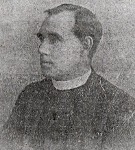 Robert William Harris (1897-1903)
Robert William Harris (1897-1903)
[left in 1903] was born in Stepney in 1863 (his father was a civil engineer),
educated at the City of London School and was a Scholar of Hertford
College Oxford. After a curacy in Poplar and a few months in Great
Yarmouth assisting the former Rector of Limehouse in a new post, he
returned to London as Secretary of the East London Church Fund, with the
Bishop of Stepney as President; it raised about £20,000 a
year to
support the work of local churches. His first appearance in the parish
was as officiant at a wedding at St Matthew Pell Street in 1889, where
he signed himself as 'Mission Preacher to the Bishop of Bedford'. He
had private means. Charles Booth made positive comments on his ministry here. But, as with his predecessor
C.H. Turner, he found that his
wife Eleanor Gertrude Ward (a parson's daughter from Clapham in north Yorkshire) and their
children Monica and Robert could 'no longer
live here' and he exchanged his living with F. St J.
Corbett [below],
and became Rector of Long Marton in Carlisle diocese, three miles from
Appleby-in-Westmorland and twelve from Penrith, where he served for 34
years. ('Exchange' was a
not uncommon practice in the past: Bryan
King and John Lockhart Ross had done the same in 1863, and Neville
Jones and John Lyons in 1847 at St Mark Whitechapel.)
His previous experience of northern ministry was as an annual missioner
at Addingham in west Yorkshire.
He was well-regarded in the village. For all these years he was ex officio chairman
of the local Parish (now Village) Institute, providing a reading room
and recreation room with a hall above, built by his predecessor in
1980. During the First World War he failed to introduce whist drives,
as the deeds strictly forbade card games. It took until the 1920s to
overturn this - and the minute books show that this did not
please everyone!
 But after 17 years in the East End, as the Westmorland Gazette put it when he retired in 1938, Mr
Harris found himself in surroundings which strangely differed from
those in which hitherto his life as a clergyman had been spent. The
last thing he expected was to become a country parson. In a very short
time he began to find outlets for his abounding energy, for he was
embued with a fervour of Churchmanship and an activity of mind and body
that could not be cabined and confined to one country parish. From
1906-22 he was the organising
secretary for the
Society for the Propagation of the Gospel in the archdeaconry of
Carlisle. For 25 years, from 1910, he was Rural Dean of
Appleby & Kirkby
Stephen. During the First World War he served as chaplain to the 2nd
Western Mounted Brigade (which included the Westmorland and Cumberland
Yeomanry), and after the war was elected a Proctor
in Convocation, and so became one of the original members of the new
Church Assembly (the precursor of General Synod), serving until 1931.
Here he spoke in favour of Prayer Book Revision (see here for more detail), and as a
critical supporter of the 1923 Dilapidations Measure
which sought to reform the cumbersome procedures for financing repairs
to parsonage houses. He also favoured reform of the glebe system,
whereby part of the parson's stipend was made up from variable annual
rents on land; he sold 600 acres of his own glebe, producing a
guaranteed annual income of £300.
But after 17 years in the East End, as the Westmorland Gazette put it when he retired in 1938, Mr
Harris found himself in surroundings which strangely differed from
those in which hitherto his life as a clergyman had been spent. The
last thing he expected was to become a country parson. In a very short
time he began to find outlets for his abounding energy, for he was
embued with a fervour of Churchmanship and an activity of mind and body
that could not be cabined and confined to one country parish. From
1906-22 he was the organising
secretary for the
Society for the Propagation of the Gospel in the archdeaconry of
Carlisle. For 25 years, from 1910, he was Rural Dean of
Appleby & Kirkby
Stephen. During the First World War he served as chaplain to the 2nd
Western Mounted Brigade (which included the Westmorland and Cumberland
Yeomanry), and after the war was elected a Proctor
in Convocation, and so became one of the original members of the new
Church Assembly (the precursor of General Synod), serving until 1931.
Here he spoke in favour of Prayer Book Revision (see here for more detail), and as a
critical supporter of the 1923 Dilapidations Measure
which sought to reform the cumbersome procedures for financing repairs
to parsonage houses. He also favoured reform of the glebe system,
whereby part of the parson's stipend was made up from variable annual
rents on land; he sold 600 acres of his own glebe, producing a
guaranteed annual income of £300.
He was an Anglo-Catholic - a member of the Church Union, serving as chairman of the Penrith and Appleby branch. In his spare time he was an active member of the
Cumberland and Westmorland Bee-Keepers' Association. He retired to
Ilkley in 1938 [pictured right], where six years later he celebrated his golden wedding. One of his sons became the Vicar of Casterton, near Kirkby Lonsdale.
We are grateful to Keith Spence, of the Long Marton Local History Group, for images, press cuttings and minute book extracts.
Frederick
St John Corbett FRSL FRHistS (1903-19)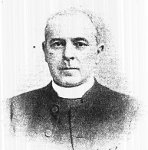
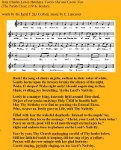 was the son of John Corbett, an Irish senator and Principal of the
Government Training College in Dublin. A graduate of Trinity College
Dublin, he served curacies in Leeds, where he was also Acting Chaplain
to the Leeds Rifles - the Prince of Wales Own (West Yorkshire) Regiment
- and then at St Michael Chester Square in the West End, where he began
his
publishing career with Sermon Outlines (1891), The Preacher's Year - 58 outline sermons (1894) and Life from a Parson's Point of View (1893, described by The Times as a lively and humourous little volume of clerical stories by a West-end curate and by the Dean of Llandaff (presumably without the implications it
would have today) I can sincerely call it
interesting,
clever and suggestive. Echoes of the Sanctuary (1892) was a collection of none-too-distinguished hymns. See right for a Christmas hymn still sung in the USA.
was the son of John Corbett, an Irish senator and Principal of the
Government Training College in Dublin. A graduate of Trinity College
Dublin, he served curacies in Leeds, where he was also Acting Chaplain
to the Leeds Rifles - the Prince of Wales Own (West Yorkshire) Regiment
- and then at St Michael Chester Square in the West End, where he began
his
publishing career with Sermon Outlines (1891), The Preacher's Year - 58 outline sermons (1894) and Life from a Parson's Point of View (1893, described by The Times as a lively and humourous little volume of clerical stories by a West-end curate and by the Dean of Llandaff (presumably without the implications it
would have today) I can sincerely call it
interesting,
clever and suggestive. Echoes of the Sanctuary (1892) was a collection of none-too-distinguished hymns. See right for a Christmas hymn still sung in the USA.
In
1896 he became Rector of Long Marton, near Appleby. He continued to publish: The Problem of Life (1896), contributions to Funeral Sermons & Addresses - An Aid to Pastors (1899), A Thousand Things to Say in Sermons (1901), and editing The Service of Perfect Freedom
(1902), a collection of sermons preached by his father-in-law Canon
Edmund Askew, who was Vicar of Greystoke. He also produced a novel Two
Men and a Girl (Gay
&
Bird 1902) on the ‘romantic entanglements of English
aristocracy’.
As
explained above, he exchanged livings with Harris and became Rector of
St George-in-the-East in 1903 (seeking a more strenuous sphere of work as his obituary in The Guardian of 27 March 1919 put it). Here he produced his major scholarly
work, A
History of
British Poetry from the Earliest Times to the Beginning of the
Twentieth Century
(Gay &
Bird 1904), as well as The Communicants' Little Book (1904), a poetical tribute to George Herbert (1906), an illustrated poem Led by a Little Child (106) which sold several thousand copies, A Thousand Thoughts for Practical Preachers
(1910) and material for the Church of England Guild of Sponsors [see here for this scheme, which he had devised], A
Church of England Women's Society and sermons for harvest and flower
festivals.
 He was a good
organiser, a pioneer of church finance reform, and in parish magazines of the time he brought
the parish's history up to date. He faced many problems,
detailed in this report
to the Bishop of Stepney. Although he had his own London house, in Hanover Square, he
did not have his predecessors' private incomes. He
was Chaplain to the 3rd Volunteer Batallion of the Territorial Force
(given the honorary rank of Lieutenant-colonel in 1917), governor of
the East London Hospital for Children, chairman of managers of the St
George's group of LCC schools and a member of the Diocesan Advisory
Committee. He died in office of pneumonia, the after-effects of
the Spanish flu epidemic, as a result of his local ministrations. In 1965 a set of altar cruets in his memory was given by the family.
He was a good
organiser, a pioneer of church finance reform, and in parish magazines of the time he brought
the parish's history up to date. He faced many problems,
detailed in this report
to the Bishop of Stepney. Although he had his own London house, in Hanover Square, he
did not have his predecessors' private incomes. He
was Chaplain to the 3rd Volunteer Batallion of the Territorial Force
(given the honorary rank of Lieutenant-colonel in 1917), governor of
the East London Hospital for Children, chairman of managers of the St
George's group of LCC schools and a member of the Diocesan Advisory
Committee. He died in office of pneumonia, the after-effects of
the Spanish flu epidemic, as a result of his local ministrations. In 1965 a set of altar cruets in his memory was given by the family.
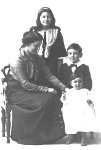
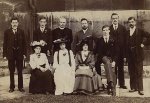 Pictured left (in Cumbria) are his wife Elsie Lucy Victoire Askew, and children Elsie
Mabel St John, Edmund St John and Mary Eleanor St George, and (at St George's) a family group. A younger
son, Capt Hugh Askew Corbett DSO DSC RN, visited the parish in 1993 and
kindly provided copies of material from his father's scrapbook about
the Queen's visit in 1904, plus an extended and revealing press interview
from the same period and material about the Guild of Sponsors, which
can be seen here; he died on 19 April 2012, aged 95 - here are two obituaries, one by his grandson.
Pictured left (in Cumbria) are his wife Elsie Lucy Victoire Askew, and children Elsie
Mabel St John, Edmund St John and Mary Eleanor St George, and (at St George's) a family group. A younger
son, Capt Hugh Askew Corbett DSO DSC RN, visited the parish in 1993 and
kindly provided copies of material from his father's scrapbook about
the Queen's visit in 1904, plus an extended and revealing press interview
from the same period and material about the Guild of Sponsors, which
can be seen here; he died on 19 April 2012, aged 95 - here are two obituaries, one by his grandson.
John Christian Pringle (1919-25)
Many
local clergy had engaged, as supporters or critics, with the Charity Organisation Society (COS) - see, for example, the comments about former
curate Henry Iselin, a staunch advocate -
but the next Rector, J.C. Pringle,
had been its full-time Secretary from
1914-19, succeeding Charles Stewart Loch, who had held the post since
1875. Pringle was educated at Cargilfield (the first Scottish prep
school) and Winchester, and read classics at Exeter College Oxford. He
served as a judge in Sind with the Indian Civil Service, but resigned
to train for ordination at Cuddesdon, serving curacies with Henry Mosley at Poplar in 1902, and then at St John-at-Hackney. In 1910 he
went for three years to be head of the
Higher Normal College in Hiroshima, a missionary college, where he
taught English. He returned to England for his first stint with the
COS, combining this with curacies at St Peter Eaton Square and then St
Mary Lambeth. Having formerly been a second lietuenant with the Sindh
Rifles Volunteers, he served temporarily in the same rank with the
1st/11th Batallion of the County of London Volunteer Regiment.
His
period as Rector here seems not to have been an entirely happy time for him.
With no 'private means' he struggled financially, having to find over
£800 for work on the
Rectory (apart from papering and painting), paying off the accumulated
dilapidations debt, and providing cover during his extended trip with
the Mission of Help to India in 1922. Parish finances after the war were also
desperate - see these documents
on the sale of church plate in 1920. His wife was unwell - which
eventually
triggered his resignation. He resented the lack of a curate (the Bishop
said the size of the congregation did not justify it), though the
parish workers who were provided undertook much pastoral work
while he was
engaged in the committee activities on which he believed the future
well-being of the church depended. His sermons and talks failed to
connect with
the congregation, perhaps not surprisingly since he chose topics such
as 'periods of church history' - Sunday morning addresses for
children, on which their autumn examination was based (and including
the surprising claim that 1700 to the present day has been among the most active and
encouraging periods of the Church); 'the influence of Roman,
Greek and and Egyptian building on
church architecture'; and in Lent 1924 'the tragic and truly Lenten
story of the conquest, perversion and desolation of the fair lands of
the Early Church by Islam'. He expressed sometimes startling political
views in forthright terms. But he comes across as one who was more
interesting and less
'churchy' than most
parsons, committed to working ecumenically as well as with the
Jewish
community (particularly at Armistice-tide). See
this selection of his writings from the parish magazine,
including his very sad farewell letter describing his time here as a
failure. In fact in the coming years he was regularly welcomed back
both as a preacher and, with his wife, as a guest at parish events, and
was well-respected by many. For his first three years he was also an
examining chaplain for the Bishop of Chester, and then chaplain of the
Royal Foundation of St Katharine until 1932.
 However, he returned to full-time COS
work, from 1925 until he resigned on health grounds in 1936, continuing
as Consulting Secretary until his death two years later. The
COS, with its various local groups, had long argued for targeting
relief on the basis of careful casework.
Pringle's magnum opus had
been the
submission, with Cyril Jackson, to the 1910
Poor Law Commission
on
the effects of employment or assistance on dockworkers since
1886. He
remained deeply suspicious of any form of intervention that might erode
self-reliance. He served on the London County Council's Public
Assistance Committee, attended international conferences, and
wrote papers
and reports on many subjects (one example is 'The Japanese Government
and Sugar') and several books, including his last work Social Work of the London Churches (1937).
In British Social
Services: The
Nation’s Appeal to the Housewife and her Response
(Longmans, Green & Co, 1933) - which he discussed with his former
parish worker at St George's, Phyllis Hatton - he claimed (on what
basis?) that
ordinary women believed that social need should be met by self help or
charity, with the state provision as a last resort: Everything
else, the housewife said, we either paid for by ourselves or got when
we needed it, from some charitable institution.
However, he returned to full-time COS
work, from 1925 until he resigned on health grounds in 1936, continuing
as Consulting Secretary until his death two years later. The
COS, with its various local groups, had long argued for targeting
relief on the basis of careful casework.
Pringle's magnum opus had
been the
submission, with Cyril Jackson, to the 1910
Poor Law Commission
on
the effects of employment or assistance on dockworkers since
1886. He
remained deeply suspicious of any form of intervention that might erode
self-reliance. He served on the London County Council's Public
Assistance Committee, attended international conferences, and
wrote papers
and reports on many subjects (one example is 'The Japanese Government
and Sugar') and several books, including his last work Social Work of the London Churches (1937).
In British Social
Services: The
Nation’s Appeal to the Housewife and her Response
(Longmans, Green & Co, 1933) - which he discussed with his former
parish worker at St George's, Phyllis Hatton - he claimed (on what
basis?) that
ordinary women believed that social need should be met by self help or
charity, with the state provision as a last resort: Everything
else, the housewife said, we either paid for by ourselves or got when
we needed it, from some charitable institution.
The COS approach had always attracted controversy, and was rejected outright by the more radical clergy of the area. (Although Canon Samuel Barnett at St Jude Whitechapel (1872-93) had been a strong supporter, he was later to lead a revolt against the 'old guard' and their resistance to state pensions). In later years, the emphasis on family casework came to be regarded as distinctly old-fashioned and patronising. (Fr John Groser in his time at Christ Church Watney Street, a few years after Pringle's time here, would have nothing to do with it.) More progressive attitudes were prevailing.
In the 1920s Pringle began to take an interest in the new, and as yet undiscredited, 'science' of eugenics, as did others - not all of them reactionaries, as the list here shows. He was a member of the Eugenics Society Council, writing a number of articles on the subject (see, for example, this 1926 article on the Merxplas Beggars Colony in Belgium), and became a Fellow in 1937 the year before he and his wife died, at their home in Blackheath. B.E. Astbury, his successor as COS Secretary, wrote in in the 1938 Eugenics Review, His death deprvies social work in this country of one of its most brilliant exponents and philosophers ... A man of charming personality, Mr. Pringle was the accepted authority on family case-work and social legislation in this country. His counsel and advice were sought by social workers from every part of the world. His essential kindliness, his humility, and his great fund of knowledge, made him,among those who knew him, widely loved. Another colleague wrote, in the Journal of Social Work (vol 74) In the world of social work I see no one to take his place. He brought such a vigorous and completely individual mind to every question free from all prepossessions as to the 'correct' or orthodox way of looking at it, and if his own strong view did not always meet with one's complete agreement, it was always stimulating, and sent one searching into the foundations of one's own position. And his industry in study and in keeping abreast of all that was being thought was really staggering.
The
John
Christian Pringle Memorial Fund, established in his memory and
administered by the Family Welfare Association, supports students in
family casework, particularly young social workers studying social
problems and the philosophy of family casework. The Social Service Quarterly (37/38, 1963, p25) includes an article about his life by B.E. Astbury.
Charles
John Beresford (1925-37)

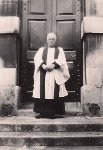
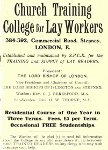
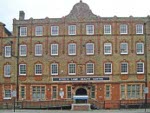
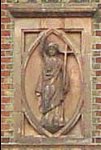 had been on the
staff of the Society for the Propagation of Christian Knowledge
(SPCK)
Training College for Lay Workers, the first institution of its kind
nationally, which opened in 1889, initially in a converted boot factory
with 7 students. He became Sub-warden in 1898 (with Ernest Robert Ford as Warden), the year that new
premises at 384-392 Commercial
Road [left] were opened, providing accommodation for 40, and became Warden and
Chaplain in 1904. The college was founded in the belief that working men were best approached by members of their own class (see W.K. Lowther Clarke A History of the SPCK (SPCK 1959) p162). It was a few
doors away from St John's Vicarage at 400, with a maternity hospital
in between at 394-398 (which in 1926 took over the college site as well; it is now a health centre). When Beresford came to St
George-in-the-East he was already well-known here as a regular
preacher. He was unmarried, living with his sister [pictured right], and died suddenly
in office.
had been on the
staff of the Society for the Propagation of Christian Knowledge
(SPCK)
Training College for Lay Workers, the first institution of its kind
nationally, which opened in 1889, initially in a converted boot factory
with 7 students. He became Sub-warden in 1898 (with Ernest Robert Ford as Warden), the year that new
premises at 384-392 Commercial
Road [left] were opened, providing accommodation for 40, and became Warden and
Chaplain in 1904. The college was founded in the belief that working men were best approached by members of their own class (see W.K. Lowther Clarke A History of the SPCK (SPCK 1959) p162). It was a few
doors away from St John's Vicarage at 400, with a maternity hospital
in between at 394-398 (which in 1926 took over the college site as well; it is now a health centre). When Beresford came to St
George-in-the-East he was already well-known here as a regular
preacher. He was unmarried, living with his sister [pictured right], and died suddenly
in office.
Reader ministry
The SPCK college trained parish workers and Readers
for licensed ministry in parishes. The preaching and teaching ministry
of (Lay) Readers was
revived in the Church of England in 1866, to meet the needs of both
urban and rural parishes where clergy were hard-pressed. They conducted
Morning and Evening Prayer, and preached - ridiculously, from the
lectern rather than the pulpit, with a pause after the service - until
the Second World War. Women were admitted as Readers during and after
the First World War, though at first were known as 'Bishops'
Messengers'. There are now over 10,000 Readers (also known as Licensed
Lay Ministers, LLMs) in the Church of England.
Beresford
was a convinced advocate of this ministry, and in his time as Rector
here several of his former students came to preach and assist in the
parish. At the 1908 Pan-Anglican
Congress (in conjunction with the Lambeth Conference of that year)
he had spoken at a session on Lay Ministry, held at the King's Hall,
Holborn
Restaurant, on 18 June (chaired by the Bishop of Stepney); the report
says
| The Rev. C. J. BERESFORD, Warden of the S.P.C.K. Training College, felt with the first speaker that the reader movement had come to stay, but he was quite sure that its development depended upon three conditions. The first was that the best man must be obtained: in days gone by, the fool of the family was generally sent into the Church. He believed that the lay reader needed much more force of character and spiritual power (and really exceptional gifts) than the ordained man, as he had nothing of the prestige of Holy Orders to carry him through his work. Lay readers had to make their own way, and therefore they must be the best men obtainable. The second condition was that after obtaining the best men, the Church needed to train them. A good deal of mischief had been done in the past, and the Church had yet to live it down, through the employment of untrained men as lay readers. Thirdly, when the best men had been obtained and trained, the Church wanted to keep and encourage them. He thought the clergymen ought to let the lay reader see that they recognized him as a responsible servant of Christ, that they felt that he had his place, his office and work, and the dignity belonging to that place, office and work. On the other hand, he thought sometimes the Church needed to discourage lay readers from attempting work which was not within their proper sphere. |
(Earlier in the day a former curate of the parish, A.E. Joscelyne, who had become Bishop-Coadjutor of Jamaica, had spoken about the involvement of lay people in his diocese as members of parochial councils.)
Beresford
would surely have been pleased that from 2010-12 part of Reader/LLM training
for the Stepney area was delivered in the crypt of St
George-in-the-East, under the auspices of St Mellitus College.
Choral music
He
was also a keen and accomplished musician (a cellist, and conductor),
and founded the
Stepney Orpheus Choir in 1908. They rehearsed here during his time
as
Rector, and he set up various other choirs in the parish. He was a
friend of Sir Walford Davies, an early broadcaster on musical matters,
who worked
with him on the annual choral festival at the People's Palace, Mile End
Road, held in the Queen's Hall there - now part of Queen Mary College:
the Musical Times 'Competition Festival Supplement' of 1909 mentioned that that was a commodious arena containing a large organ. Walford Davies brought his choir from St
George's Windsor here for the bicentenary of the parish - an unusual
honour for a parish church. More details about the bicentenary, and the
musical life of the parish, here.
Beresford
served on various national music committees: in 1926 he was a speaker
at the first annual conference of the National Association of
Competitive Choirs, held in Halifax. He became chairman of the British
Federation of Music Competition Festivals, and in 1933 chaired a major conference on ‘The Future of Amateur
Music-Making’ held at
Broadcasting House (with 'lunch at Pagani's'): Sir John Reith &
Sir Adrian Boult
represented the BBC, and a number of leading music educators
spoke.
In that same year, he conducted a lengthy memorial service for the former assistant matron of St George's Hospital, Wapping. She had come as a staff nurse in 1894, retiring 32 years later, and was a keen churchgoer - one of many examples of committed service to East End nursing,
 Robert
Bruce
Eadie (1937-42)
Robert
Bruce
Eadie (1937-42)
had served as a First World War chaplain (and remained
an honorary chaplain to the forces), and had
worked in various London parishes, in North Kensington, Shoreditch and Clapton. He left St George's in 1942 when
emergency parish staffing measures were taken (glad, it was said, to get away from the war-torn East End),
and became Vicar of St Margaret Uxbridge [right], remaining there until his death in 1953; a stone tablet was affixed in the nave in 1955.
St John Beverley Groser
(Vicar of Christ Church Watney Street 1929-48 and Curate-in-Charge of St George-in-the-East w St John Golding Street 1941-47)
See here
for an account of Fr Groser's life, and his leadership of the parish during and
after the Second World War, reconfigured after the Blitz. He brought a
radically new and inspirational style at a time of crisis, and is
rightly remembered as one of the great East End parish priests.
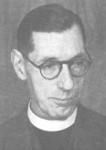 Kenneth
John (Jack) Mackay Boggis (1947-55)
Kenneth
John (Jack) Mackay Boggis (1947-55)
had
been Fr Groser's curate at Christ Church (1932-6), and (after serving in parishes elsewhere) succeeded
him as Rector at St George's. See here for an account of his life, including his tribute to Fr Groser.
Harold Ernest Farington (1955-57)
It
was ironic (and deliberate on someone's part?) that Jack
Boggis'
successor as Rector had been a Conservative member of Westminster
City Council. appointed in a 1945 by-election for
Victoria Ward, while a curate at All
Saints Pimlico, and
re-elected later that year by 3,250 votes, 47.7% of the 30.5% of the
20,082 electors who
voted, a swing of 25.7% to the party. (Lady Winterton also stood in the same election.) Ten years later, Harold Ernest Farington (born in Liverpool in 1908) came
here as Rector. He left rather suddenly, during a jumble
sale, and served a prison sentence for importuning under-age boys, but
nevertheless later become a
curate
in Cranford, and then in Malvern Link. Such, regrettably, were the
practices of the time, for which this parish becomes a footnote in the
terrible contemporary saga of child sex abuse. He died in Malvern in 1990, aged 82.
Alexander (Alex) Mackertich Solomon (1958-78)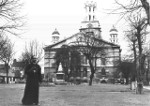
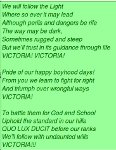 It
fell to the next Rector to inspire and
co-ordinate the remodelling of St George's, which he describes in detail here (with photographs), so ending the period of St
George-in-the-Ruins with the consecration of the new church in 1964. Fr Solomon graduated
from
Serampore College in 1932, coming to England to train for
ordination at St Augustine's College
Canterbury (where he was a member of the cricket team - a lifelong
passion). After a title in Camberwell, he returned to Calcutta
diocese, first as chaplain at Anasol and then as chaplain of Victoria
and Dow Hills Schools in Kurseong, near Darjeeling
(1945-50 and after a brief return to England, as acting curate of St
James the Less Westminster 1951-53). Here he
had the privilege (afforded to few) of writing a school song [right].
It
fell to the next Rector to inspire and
co-ordinate the remodelling of St George's, which he describes in detail here (with photographs), so ending the period of St
George-in-the-Ruins with the consecration of the new church in 1964. Fr Solomon graduated
from
Serampore College in 1932, coming to England to train for
ordination at St Augustine's College
Canterbury (where he was a member of the cricket team - a lifelong
passion). After a title in Camberwell, he returned to Calcutta
diocese, first as chaplain at Anasol and then as chaplain of Victoria
and Dow Hills Schools in Kurseong, near Darjeeling
(1945-50 and after a brief return to England, as acting curate of St
James the Less Westminster 1951-53). Here he
had the privilege (afforded to few) of writing a school song [right].
Nora Facey, who had grown up in Newfoundland where her Newfoundlander father was the principal of Queen's Theological College in St John's but had come to England in the 1930s, met Alex when he was at Camberwell, and as soon as the war was over she made her way, alone, to Calcutta and was married to him immediately on her arrival. They returned to England in 1953, to curacies in Fletton and Perivale, before his appointment to St George-in-the-East. The East London Advertiser of 9 May 1958 reported his arrival:
'Solly' in his Austin 7 was, let us say, an uncertain driver who occasionally went the wrong way round roundabouts. (A local family, allegedly more in fun than for racist motives, once marked his car 'Caution: Indian Driver'.) In his time, St Paul Dock Street with St Mark Whitechapel was attached to the parish, and he became Curate-in-charge from 1968-71 before becoming Rector of the united parish in 1971. Since then it has been known as 'St George-in-the-East with St Paul'. This is not entirely fair to the other former churches in the parish: Christ Church, St Matthew, St John and St Mark, whose names have 'disappeared'.
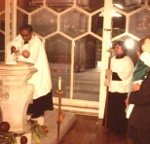 His
vision of the remodelled church community meant that he and Nora
lived in the church,
with rooms on two floors at the south-west corner, rather than in the
Rectory. As a result, the Rectory, like the flats created in the
church, were tenanted over the years
by 'his team' - a succession of people who worked at St George's or for the wider
church, including religious journalists, authors and actors: see here for more details. And see here for an incident in 1976 when the crypt housed a bunch of Angola-bound mercenaries for the night. During a sabbatical, the Revd Richard (Dick) Alexander Yates looked after the parish.
His
vision of the remodelled church community meant that he and Nora
lived in the church,
with rooms on two floors at the south-west corner, rather than in the
Rectory. As a result, the Rectory, like the flats created in the
church, were tenanted over the years
by 'his team' - a succession of people who worked at St George's or for the wider
church, including religious journalists, authors and actors: see here for more details. And see here for an incident in 1976 when the crypt housed a bunch of Angola-bound mercenaries for the night. During a sabbatical, the Revd Richard (Dick) Alexander Yates looked after the parish.
Alex
Solomon was an
accomplished pianist, and acquired two grand pianos - a Broadwood for
the church and
a Blüthner for the crypt hall (now restored and also in the church); in
his time, the crypt hall was extensively used for
music-making. He was also a keen cricketer, and played in the diocesan
team (and was remembered in this role by a fellow-enthusiast, Canon
Michael Saward, a member
of our congregation until 2012).
The Solomons retired to Worthing in April 1979 after celebrating the 250th anniversary of the church at St George's-tide. He
continued to exercise a ministry in his local church; in 1986 he wrote this
reflection on his ministry here, in protest at current plans for the
parish. He died at the age of 73; his obituary in the Church Times (16
October 1987) was written by the deputy editor Alan Shadwick, one of the 'team' at St George-in-the-East. He describes him as an Indian ... who loved the best in England, and commented that many will remember the sound of music from his rooms when the day's work was done.
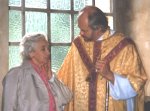
 After his death,
Nora lived on until her death in February 2010,
aged 95, joined by her niece Ros after the death of her father in 1997 (see this
note about her wedding in the Upper Room in 1960). Nora is pictured
left, collecting in Watney Street in the 1960s with parish worker Morwenna Tredinnick [a clip from a wonderful selection of film images screened by BBC4 on 25 June 2012 as 'London on FIlm: the East End'] and right in July 1992 with Richard Chartres, then Bishop of
Stepney (now Bishop of London) at the dedication of the memorial plaque
to Fr Solomon.
After his death,
Nora lived on until her death in February 2010,
aged 95, joined by her niece Ros after the death of her father in 1997 (see this
note about her wedding in the Upper Room in 1960). Nora is pictured
left, collecting in Watney Street in the 1960s with parish worker Morwenna Tredinnick [a clip from a wonderful selection of film images screened by BBC4 on 25 June 2012 as 'London on FIlm: the East End'] and right in July 1992 with Richard Chartres, then Bishop of
Stepney (now Bishop of London) at the dedication of the memorial plaque
to Fr Solomon.
Ulrich Eduard Erich Julian Scharf (1979-86)
When
Alex Solomon left, there was uncertainty about the staffing of St
George's. In the event, Julian Scharf took on the responsibility. He
had been Priest-in-charge of St Paul Shadwell since 1975, and four years
later became also Rector of St George's. Julian is the son of the artist Theo Scharf (pictures and biography here)
and grew up in Germany and Australia, where he attended Melbourne
University. He studied theology and trained for ordination at Ripon
Hall, Oxford; during his time at St George's he completed a London PhD.
After a curacy at St
John Hackney he had been part-time chaplain to Trevor Huddleston, Bishop of Stepney: Piers McGrandle Trevor Huddleston: Turbulent
Priest (Continuum 2004) describes their
daily routine.
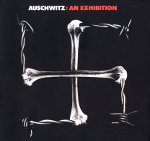
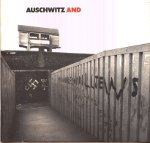
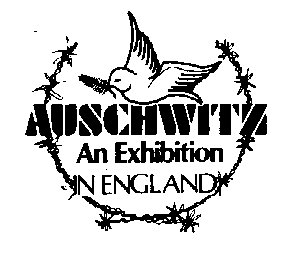 A
major event in his time here was the still-remembered 1983 exhibition
in
the crypt hall 'Auschwitz and the East End', organised by a committee
chaired by
Jim Thompson, the Bishop of Stepney. 20,000 people visited, after which
it went to Birmingham in preparation for further appearances is six
major cities over the following two years. Tower Hamlets Arts Project
produced two booklets, 'Auschwitz And...' (with brief essays by
well-known local figures) and 'Auschwitz: an exhibition' [full texts of
both right]. Hugh
Montefiore, Bishop of Birmingham and a Jewish convert, gave a Lent
lecture to clergy of the Stepney area; another outstanding talk was
given by Lord Elwyn-Jones,
a Welsh barrister who lived in Germany for a time and was involved in
the Nuremberg trials, MP for Plaistow and then West Ham South, later
Attorney-General and Lord Chancellor - and father of Dan Jones who with
his wife Denise has had long involvement in local political life and still live in Cable Street. (See here for a brief historical overview of the local Jewish presence.)
A
major event in his time here was the still-remembered 1983 exhibition
in
the crypt hall 'Auschwitz and the East End', organised by a committee
chaired by
Jim Thompson, the Bishop of Stepney. 20,000 people visited, after which
it went to Birmingham in preparation for further appearances is six
major cities over the following two years. Tower Hamlets Arts Project
produced two booklets, 'Auschwitz And...' (with brief essays by
well-known local figures) and 'Auschwitz: an exhibition' [full texts of
both right]. Hugh
Montefiore, Bishop of Birmingham and a Jewish convert, gave a Lent
lecture to clergy of the Stepney area; another outstanding talk was
given by Lord Elwyn-Jones,
a Welsh barrister who lived in Germany for a time and was involved in
the Nuremberg trials, MP for Plaistow and then West Ham South, later
Attorney-General and Lord Chancellor - and father of Dan Jones who with
his wife Denise has had long involvement in local political life and still live in Cable Street. (See here for a brief historical overview of the local Jewish presence.)
Gillean
Weston Craig (Priest-in-Charge 1988, Rector 1989-2002)
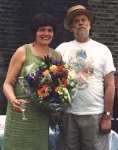
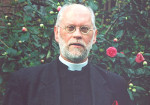 Fr
Gillean, who had studied at York University and, while training at
Westcott House, Queens' College Cambridge, had served curacies at
Marylebone parish church and St Barnabas Ealing before he came here. In
view of the ongoing uncertainties about pastoral provision in the area,
he faced many challenges during his time here, to which he responded
with flamboyance and enthusiasm. He built up parish life,
reinvogorating the worship (though not all were convinced by the dawn
eucharist on Easter morning or Ascension Day carols at the top of the
tower!) and forging strong links with our primary school (which at that
period, though increasingly Muslim in intake, continued to produce a
trickle of confirmation candidates), and hosted many sociable
gatherings. In 1991 he married at St George's the opera singer Dr Linda Hirst,
of Trinity College of Music [now Trinity Laban Conservatoire of Music
& Dance], whom he had met when he was an unpaid 'trog' (piano
shifter) at the Dartington summer school. He read his own banns - which
is lawful, though unusual nowadays. Linda brought many musical contacts
- including our former
organist Elspeth Wilkes.
Fr
Gillean, who had studied at York University and, while training at
Westcott House, Queens' College Cambridge, had served curacies at
Marylebone parish church and St Barnabas Ealing before he came here. In
view of the ongoing uncertainties about pastoral provision in the area,
he faced many challenges during his time here, to which he responded
with flamboyance and enthusiasm. He built up parish life,
reinvogorating the worship (though not all were convinced by the dawn
eucharist on Easter morning or Ascension Day carols at the top of the
tower!) and forging strong links with our primary school (which at that
period, though increasingly Muslim in intake, continued to produce a
trickle of confirmation candidates), and hosted many sociable
gatherings. In 1991 he married at St George's the opera singer Dr Linda Hirst,
of Trinity College of Music [now Trinity Laban Conservatoire of Music
& Dance], whom he had met when he was an unpaid 'trog' (piano
shifter) at the Dartington summer school. He read his own banns - which
is lawful, though unusual nowadays. Linda brought many musical contacts
- including our former
organist Elspeth Wilkes.
In
Gillean's first year here there were two tragedies. Six months after
the wedding of Debbie and Steve Faldo at St George's in February 1989,
Steve died when the Marchioness,
the disco boat of which he was skipper, sank in the Thames after a
collision with a gravel dredger. And in 1990 he was shocked on going into church when he heard noises to
find that 25-year old Mark Hazlewood, from Stratford, had attempted to
hang himself. He was gasping for breath and breathing violently;
Gillean cut him down, and resuscitated him and he was taken to the
Royal London Hospital and put on life support.
Two
particular projects absorbed much energy and produced volumes of
correspondence. He promoted a £4m project, launched in 1991, for
further remodelling of the church to provide a home for the Guildhall
Ensemble (described in detail here),
and was deeply frustrated that it eventually came to nothing - despite
a visit from the Prince of Wales in July 1992 (linked to the tenth
anniversary of Business in the Community and a series of 'Seeing
is Believing' visits). Two years later he also hosted a visit by
Princess Margaret. More successful was his meticulously-researched bid for the restoration of the Rectory, made possible only with English Heritage funding; for this his successors will ever remain in his debt.
Here are some pictures from 1998 of Fr Gillean blessing the new offices of The Times,
across the road at News International, in typically ebullient style.
NI held their first carol service at St George's ten years previously,
and this tradition continued until 2012.
Gillean is now Vicar of St Mary Abbot's Kensington – where
David
Cameron's family were members of the congregation before his move to number 10. He is the Librarian of Sion College
(although it is now a society rather than a library!) and tv critic of
the Church
Times.
John Austin Cullen (Priest-in-Charge 2003-04)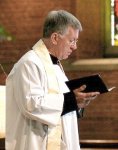
 There
followed an uncertain five years, in which various plans came and
went. Canon Dr John Cullen [left], who
was also the Bishop of London's personal
assistant, was priest-in-charge (non-resident) for eighteen months during 2003 and 2004. He is a New Zealander, who had been a ministry development
officer in Winchester diocese with wide experience of reviewing and supporting clergy;
until his retirement in 2013 he was the vicar of St John, Palmer's Green, and remains a good friend of the parish.
There
followed an uncertain five years, in which various plans came and
went. Canon Dr John Cullen [left], who
was also the Bishop of London's personal
assistant, was priest-in-charge (non-resident) for eighteen months during 2003 and 2004. He is a New Zealander, who had been a ministry development
officer in Winchester diocese with wide experience of reviewing and supporting clergy;
until his retirement in 2013 he was the vicar of St John, Palmer's Green, and remains a good friend of the parish.
In that short time here, Fr John
did much to organise the
affairs of the parish, as well as exercising a valued pastoral
ministry.
His first priority on arrival was the provision of a new flagpole,
since health and safety officers had condemned the old one as a
dangerous structure and it had not been possible to fly the flag on St
George's Day. £3000 was raised for a new one, dedicated on the
anniversary of consecration. He organised the redecoration
of the church and the provision of service booklets, and spent much
time sorting through and dealing with the files that had accumulated in
the office.
As
he left for his new post, the diocese was
adapting part of the crypt to house the North Thames Ministerial
Training Scheme (of which the
diocese is the licence-holder); during the vacancy, a confident
congregation steered plans to convert the rest of the crypt into a home
for Green Gables Montessori Nursery.
Michael Ainsworth (Rector 2007-14 )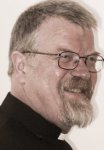 A permanent, resident post depended on two things: a congregation
committed to the ongoing mission of the parish, and staffing levels
within the deanery of Tower Hamlets. When a post elsewhere in the
deanery was 'lost', it became possible to advertise for a new Rector,
and various candidates were interviewed. In the event, Canon Michael
Ainsworth was appointed, and the Rectory (which had been inhabited by
clergy and other members of St Paul Shadwell) was made available.
Michael has served most of his ministry in the north-west, in parishes
and in ministerial training; most recently he had been Team Rector of
Worsley in Salford, Area Dean of Eccles, and chairman of the House of
Clergy in Manchester Diocese and Deputy Prolocutor of the
Northern Province. He continues to be involved in national church
activities, as vice-chair of the Church Buildings Council (and chair of
its organs committee), and the Anglican appointee on the ecumenical
Churches Funerals Group. He also continues his involvement in
ministerial education, as an examining chaplain, ministerial reviewer
and occasional inspector. His wife Janina (also ordained) is Chief
Education Officer of
the Church of England, and Secretary of the National Society. Michael
and Jan left the parish in October 2014 and returned to the north west,
Michael into (active) retirement and Jan as house-for-duty team vicar
of St Maxentius Bradshaw, in the Turton Moorland Team Ministry on the
north-east side of Bolton. Their address is
A permanent, resident post depended on two things: a congregation
committed to the ongoing mission of the parish, and staffing levels
within the deanery of Tower Hamlets. When a post elsewhere in the
deanery was 'lost', it became possible to advertise for a new Rector,
and various candidates were interviewed. In the event, Canon Michael
Ainsworth was appointed, and the Rectory (which had been inhabited by
clergy and other members of St Paul Shadwell) was made available.
Michael has served most of his ministry in the north-west, in parishes
and in ministerial training; most recently he had been Team Rector of
Worsley in Salford, Area Dean of Eccles, and chairman of the House of
Clergy in Manchester Diocese and Deputy Prolocutor of the
Northern Province. He continues to be involved in national church
activities, as vice-chair of the Church Buildings Council (and chair of
its organs committee), and the Anglican appointee on the ecumenical
Churches Funerals Group. He also continues his involvement in
ministerial education, as an examining chaplain, ministerial reviewer
and occasional inspector. His wife Janina (also ordained) is Chief
Education Officer of
the Church of England, and Secretary of the National Society. Michael
and Jan left the parish in October 2014 and returned to the north west,
Michael into (active) retirement and Jan as house-for-duty team vicar
of St Maxentius Bradshaw, in the Turton Moorland Team Ministry on the
north-east side of Bolton. Their address is
St
Maxentius Rectory, Bolton Road, Bradshaw, Bolton BL2 3EU, tel 01204
304240
and for the time being Michael can still be contacted on his St
George-in-the-East email address <rector.stgite@gmail.com>
CURATES
| The special mission previously mentioned was organised by the Rev. Henry Iselin of St. George's in the East and consisted mainly of ladies and gentlemen who do voluntary work in that parish. Their names appear in the balance-sheet. Mr. Richards and Mr. Barlow gave up their annual holiday to the work: the former has a post at the S.P.C.K., and the latter in the Post Office. Mr. Limbrick is Librarian of Sion College. Two of the gentlemen found rooms for themselves, and the rest of the party lived at 'Belmont', which was taken for them for the three weeks. They were not all present together, but always at least seven of the party were at work in the mission. It will be noticed that they contributed liberally towards the expenses of board and lodging. In addition to managing two coffee-stalls, this party conducted a special mission on the Hermitage Farm, working in a large tent which served as a room for lantern services, Sunday School, and concerts, and for the general purpose of a club-room. The idea came from the Paddock Wood district, where the Rev. Harry Wilson has been working on similar lines and and with great success for some years. Mr. Iselin, who has worked for two or three seasons among the hoppers in Tudely parish and whose whole life in London is spent among people of the same class, thinks that the establishment of tent-missions on large farms should be largely extended, and he reports the Hermitage experiment as encouraging. He has got an enthusiastic little band of workers and we hope that he may see his way to coming to help us again next year. In the absence of his colleague the Vicar received timely help from Mr. Iselin in the services in the Church, for which he is duly grateful. |
| The
fact remains that the Education Act, as it applies to the provision of
meals, is bad. It was an ill-considered attempt by politicians in a
hurry to appease the demands of an outcry by a section of agitators.
False to all theories of rational government, the Act has shown itself
pernicious in practice; and if its policy constitutes friendship 'for
the masses', the self-reliant poor may well pray to be saved from their
friends. At the outset social workers who, for the sake of the people
for whom they cared, have undertaken its administration,
prophesied its failure and its mischief, and their prophecies have been
too sadly fulfilled. |
| Actually,
in the last year before the [First World] War, the far-reaching
superiority of the social service rendered to the inhabitants of the
classical parish of Lambeth (9,000 souls) to the social services
rendered on any other portion of the surface of the United Kingdom, had
so impressed the leaders of the London County Council that plans were
in active preparation to extend the Lambeth service to three
neighbouring parishes, under the aegis of the London County Council
itself. In the last complete peace-time year of that service, 50,000
visits were paid in the homes of that population and records of them
written up by the staff, under the supervision of Miss Edith Herbert,
who was in charge of the Rectory Room. The whole enterprise depended
upon the consummate ability of Canon T. G. Gardiner, Rector of Lambeth.
His Grace the late Archbishop of Canterbury, Dr. Randall Davidson, was
a close observer of the operation of the scheme in detail, and lent it
his hearty approval. The only clergyman comparable, in his grasp of the technique of social service in a parish, to Canon Gardiner, was and is the Rev. Henry Iselin, for eighteen years curate in the parish of St. George's-in-the-East, London Docks. Mr. Iselin's organization, on a parochial basis, of an Infant Welfare Service, based on the Act of 1907; the School Care Committee Service, based on the Acts of 1906-07; the Tuberculosis Care Service, and allied services which need not be enumerated, was an arrangement of astonishing perfection, and had the support and approval of all denominations and social agencies. Unhappily, the Hayes-Fisher Act of 1918 gave the Local Authorities powers of too over-riding a character, and the Labour Party coming into power for the first time in the borough, in 1919, failed to understand the scheme and swept away the Infant Welfare section of Mr Iselin's scheme. The remainder of it was kept in being for another eight or nine years. |
 Henry
Iselin continued his involvement with COS when in 1916 he became vicar of
St Nicholas Rawreth in Essex, a Pembroke College living (though St John's College Cambridge and Sion College were the principal landowners); here we find
him supervising
research into
the
new field of 'industrial
psychology'. He remained there, at a house called 'Telfords', for about
25 years. In 1928 he entered an Airedale Terrier puppy, 'Rawreth Kim', at Crufts (but according to the programme left without success). He was one of a 'League of Nations Union party' - described
by its leader, the Fabian author Frederick Leman Whelan, as a group of
'useful idiots' - who visited the USSR in 1936. In 1945 his ashes were interred in the sanctuary of Rawreth church.
Henry
Iselin continued his involvement with COS when in 1916 he became vicar of
St Nicholas Rawreth in Essex, a Pembroke College living (though St John's College Cambridge and Sion College were the principal landowners); here we find
him supervising
research into
the
new field of 'industrial
psychology'. He remained there, at a house called 'Telfords', for about
25 years. In 1928 he entered an Airedale Terrier puppy, 'Rawreth Kim', at Crufts (but according to the programme left without success). He was one of a 'League of Nations Union party' - described
by its leader, the Fabian author Frederick Leman Whelan, as a group of
'useful idiots' - who visited the USSR in 1936. In 1945 his ashes were interred in the sanctuary of Rawreth church.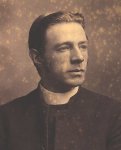 Roland
Genet Stafford (1900-04) [right]
- an Oriel, Oxford graduate who trained for ordination at Lichfield, he
came here after a curacy in Canterbury diocese. Reflecting his academic
interests, in 1903 he contributed to the Palestine Exploration Quarterly
(p.91) an account
of the Passover observances dictated in Arabic by the Samaritan High
Priest, including a rough diagram. He left London to serve for four years in the Cape and Orange
River Colonies in South Africa before returning to
various London parishes. In 1916 he published The History of a Club: what and where it is (Elliot Stock), aiming to give a historical account of Christianity, the oldest Club in existence in the Western World and the Near East, its
chapters including 'Conditions of Membership', 'Its Relation to its
Founder', 'Its Constitution and Rules'. From 1920-46 he was Vicar of St
Andrew
Kentish Town (closed and demolished in 1953); his observations on the
Blitz at this church are included in the September 2010 Newsletter of the Camden History Society:
services were regularly curtailed, and they were unable to take
advantage of the permission to ring the bells on Christmas Day 1942
because they could not raise a team, and the bells had rusted. He
died in 1953, aged 83.
Roland
Genet Stafford (1900-04) [right]
- an Oriel, Oxford graduate who trained for ordination at Lichfield, he
came here after a curacy in Canterbury diocese. Reflecting his academic
interests, in 1903 he contributed to the Palestine Exploration Quarterly
(p.91) an account
of the Passover observances dictated in Arabic by the Samaritan High
Priest, including a rough diagram. He left London to serve for four years in the Cape and Orange
River Colonies in South Africa before returning to
various London parishes. In 1916 he published The History of a Club: what and where it is (Elliot Stock), aiming to give a historical account of Christianity, the oldest Club in existence in the Western World and the Near East, its
chapters including 'Conditions of Membership', 'Its Relation to its
Founder', 'Its Constitution and Rules'. From 1920-46 he was Vicar of St
Andrew
Kentish Town (closed and demolished in 1953); his observations on the
Blitz at this church are included in the September 2010 Newsletter of the Camden History Society:
services were regularly curtailed, and they were unable to take
advantage of the permission to ring the bells on Christmas Day 1942
because they could not raise a team, and the bells had rusted. He
died in 1953, aged 83.| By arrangement with the Imperial War Graves Commision, the remains of five British soldiers buried in various parts of Roumania were conveyed to Bucharest and were permanently buried here on April 27 in the portion of the Lutheran Cemetery ascquired by a recently-formed Anglo-American Cemetery Committee. The names of the soldiers in question were: Private R. Bobley, 12th Hampshire Regt.; Private James Stirling, Seaforth Highlanders; Lance-Corporal A. Scott, Seaforth Highlanders; Corporal H. Mott, Royal Engineers; and Private Darvill, Royal Engineers. The remains had been located and covenyed to Bucharest by Captain A.F. Menzies, representative of the Commission to Macedonia. A portion of the burial service was read by the British Chaplain here, the Rev. Claude Hinscliffe. |
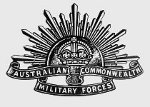 Cecil Harrington McKie (1930-32)
also lived in the Rectory. He was Australian: a clerk (son of a bank
official) from Coogee, New South Wales, who in 1916, at the age of 31,
enlisted as a private in the Australian Camel Field Ambulance service;
after the War, he trained for ordination at St John's College Armidale,
and served four posts in Golbourn and Brisbane. He came to England,
initially to Carlisle diocese, and then here for two years, but
resigned: the parish magazine reported He
has not been very well lately, and his doctor has insisted that he must
get out of London and seek for quiet work somewhere in the South.... he
will be specially missed by the sick and by the lads of his Bible
Class. Let us pray that he may find work which will enable him to renew
his health. After a brief spell as a curate in Totnes (with a return here to
provide a month's cover in 1933), and some months in the chaplaincy at
Oslo from 1935-36, he returned to Brisbane, and died there in 1939, aged 53.
Cecil Harrington McKie (1930-32)
also lived in the Rectory. He was Australian: a clerk (son of a bank
official) from Coogee, New South Wales, who in 1916, at the age of 31,
enlisted as a private in the Australian Camel Field Ambulance service;
after the War, he trained for ordination at St John's College Armidale,
and served four posts in Golbourn and Brisbane. He came to England,
initially to Carlisle diocese, and then here for two years, but
resigned: the parish magazine reported He
has not been very well lately, and his doctor has insisted that he must
get out of London and seek for quiet work somewhere in the South.... he
will be specially missed by the sick and by the lads of his Bible
Class. Let us pray that he may find work which will enable him to renew
his health. After a brief spell as a curate in Totnes (with a return here to
provide a month's cover in 1933), and some months in the chaplaincy at
Oslo from 1935-36, he returned to Brisbane, and died there in 1939, aged 53.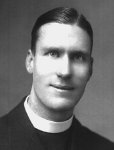 William Arthur
Winfield (1932-36) [right], a non-identical twin and one of five siblings, was born in
1907 and qualified as a jewellery-box maker, later making boxes for the
communion vessels of the parishes where he served (including perhaps
the silver gilt set still in use at this church?) He served his title
here
after King's College London, and married Beatrice, a member of the
congregation. (Such liaisons for new curates were frowned on in those
days, so they courted in secret - but were spotted meeting at Liverpool
Street station, and apparently 'reported' to the Bishop!) Further
curacies followed in Chelmsford
diocese, at Silvertown and (during the War) Great Ilford, becoming
Vicar of St John Tilbury Docks, and chaplain at Tilbury Hospital, in
1945. From 1954 he was Rector of the ancient church of St Nicholas
Laindon, and was rural dean of Basildon for ten years.
(In 1959 he conducted the funeral service of a much-loved local
doctor, following Hindu rites, at Southend crematorium.) He led the
building of St Martin's, the town-centre church for the new town of
Basildon (unusual in being designed by a female architect, and
incorporating the first-ever bell to be cast by a woman, Joanne Hille
in 1441). In 1965 he became Vicar of Christ Church, Thorpe Bay, and
died in 1974 - his ashes are buried in Laindon church, with a plaque.
His daughter remains active in the Mothers' Union at Wickford. We are grateful to his grandson Stephen for some of these details.
William Arthur
Winfield (1932-36) [right], a non-identical twin and one of five siblings, was born in
1907 and qualified as a jewellery-box maker, later making boxes for the
communion vessels of the parishes where he served (including perhaps
the silver gilt set still in use at this church?) He served his title
here
after King's College London, and married Beatrice, a member of the
congregation. (Such liaisons for new curates were frowned on in those
days, so they courted in secret - but were spotted meeting at Liverpool
Street station, and apparently 'reported' to the Bishop!) Further
curacies followed in Chelmsford
diocese, at Silvertown and (during the War) Great Ilford, becoming
Vicar of St John Tilbury Docks, and chaplain at Tilbury Hospital, in
1945. From 1954 he was Rector of the ancient church of St Nicholas
Laindon, and was rural dean of Basildon for ten years.
(In 1959 he conducted the funeral service of a much-loved local
doctor, following Hindu rites, at Southend crematorium.) He led the
building of St Martin's, the town-centre church for the new town of
Basildon (unusual in being designed by a female architect, and
incorporating the first-ever bell to be cast by a woman, Joanne Hille
in 1441). In 1965 he became Vicar of Christ Church, Thorpe Bay, and
died in 1974 - his ashes are buried in Laindon church, with a plaque.
His daughter remains active in the Mothers' Union at Wickford. We are grateful to his grandson Stephen for some of these details. Dr Arthur
Geoffrey Lough (1942-44)
was technically appointed as curate of Christ Church, Watney Street,
even though by then it had been blitzed. Born in 1912, herained at King's College
London, and had been a curate in Gloucester, and chaplain to the Bishop
of Bombay in the early years of the
war. After his time here, he served in two Kingstons -
Surrey and Jamaica - and then in Exeter diocese, as incumbent of
Hennock, near Newton Abbot (where he wrote a history of the church,
published by the Ecclesiological Society), and
rural dean of Moreton, and also taught history and civics at a girls'
school in
Newton Abbot, where he died in 1990. His doctoral thesis, The Influence of John Mason
Neale, was published by SPCK in 1962, and he produced other
works on Neale [right] and Pusey.
Dr Arthur
Geoffrey Lough (1942-44)
was technically appointed as curate of Christ Church, Watney Street,
even though by then it had been blitzed. Born in 1912, herained at King's College
London, and had been a curate in Gloucester, and chaplain to the Bishop
of Bombay in the early years of the
war. After his time here, he served in two Kingstons -
Surrey and Jamaica - and then in Exeter diocese, as incumbent of
Hennock, near Newton Abbot (where he wrote a history of the church,
published by the Ecclesiological Society), and
rural dean of Moreton, and also taught history and civics at a girls'
school in
Newton Abbot, where he died in 1990. His doctoral thesis, The Influence of John Mason
Neale, was published by SPCK in 1962, and he produced other
works on Neale [right] and Pusey.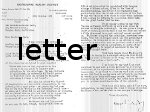 William
Denys Giddey
(1943-48) who trained
at Mirfield, came here after a curacy in Weymouth during Fr Groser's
time, and lived on the top floor of the Rectory;
when he married a local girl Mary (a schoolfriend of Edith Wyeth) they
moved to Wellclose Square. He ran the parish during Fr Groser's
sabbatical in
Germany prior to his move to St Katharine's. After 13 years in
Lincolnshire, as Rector of Binbrook and Swinhope with Thorganby (and
RAF Chaplain), he spent his later ministry as a hospital chaplain at
Guy's and then in
Eastbourne (where he wrote a brief history of All Saints' Hospital),
retiring in 1983 but continuing as an honorary Canon and Prebendary of
Chichester Cathedral, and Chaplain of St Wilfred's Hospice,
Eastbourne); he died in 2006. The church was given a
thurible stand in memory of Mary. Read this 1981 letter he wrote in
protest against the depiction of Fr Groser in a work entitled Some Clerical Oddities.
William
Denys Giddey
(1943-48) who trained
at Mirfield, came here after a curacy in Weymouth during Fr Groser's
time, and lived on the top floor of the Rectory;
when he married a local girl Mary (a schoolfriend of Edith Wyeth) they
moved to Wellclose Square. He ran the parish during Fr Groser's
sabbatical in
Germany prior to his move to St Katharine's. After 13 years in
Lincolnshire, as Rector of Binbrook and Swinhope with Thorganby (and
RAF Chaplain), he spent his later ministry as a hospital chaplain at
Guy's and then in
Eastbourne (where he wrote a brief history of All Saints' Hospital),
retiring in 1983 but continuing as an honorary Canon and Prebendary of
Chichester Cathedral, and Chaplain of St Wilfred's Hospice,
Eastbourne); he died in 2006. The church was given a
thurible stand in memory of Mary. Read this 1981 letter he wrote in
protest against the depiction of Fr Groser in a work entitled Some Clerical Oddities.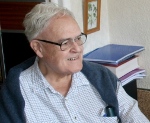 John Gisborne
Charteris Eldrid (1953-56), trained at King's College London, served
his title here (living on the top floor of the Rectory), and two
further curacies in East Grinstead and St Stephen Walbrook, the home of
The Samaritans,
of which he became London consultant, then national Director and
Consultant-Director, writing and speaking extensively. He contributed
to The
Samaritans (1978), and
his book Caring
for the Suicidal (Constable 1988), based on his long
experience, is widely used. He was awarded
an MBE for his work, and retired
in 1990, continuing to officiate in Portsmouth diocese until his death (see this obituary of 'John 250' by Wendy Robins in Church Times of 25 November 2011, and this
one by his son). The Rector, and a long-standing Samaritan friend Joan
Guénault, who became the national training director, attended a lively
memorial service for him and shared memories with his widow of their
time in the parish.
John Gisborne
Charteris Eldrid (1953-56), trained at King's College London, served
his title here (living on the top floor of the Rectory), and two
further curacies in East Grinstead and St Stephen Walbrook, the home of
The Samaritans,
of which he became London consultant, then national Director and
Consultant-Director, writing and speaking extensively. He contributed
to The
Samaritans (1978), and
his book Caring
for the Suicidal (Constable 1988), based on his long
experience, is widely used. He was awarded
an MBE for his work, and retired
in 1990, continuing to officiate in Portsmouth diocese until his death (see this obituary of 'John 250' by Wendy Robins in Church Times of 25 November 2011, and this
one by his son). The Rector, and a long-standing Samaritan friend Joan
Guénault, who became the national training director, attended a lively
memorial service for him and shared memories with his widow of their
time in the parish.



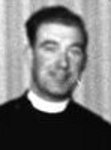 Christopher
Jonathan Bird (1963-66) trained at Sarum College, and came here after a curacy at
Riddlesdown, in Southwark diocese. He was a popular curate, and led
many activities for young people - see here
for details of some of these. He is pictured here in the parish, at his
farewell (where he showed films he had made of youth and other events)
and as Vicar of All Saints South Wimbledon, where he died suddenly of a
heart
attack on 18 July 1974, aged 44 [obituary from Wimbledon News 26 July 1974); he was buried in his home town of Kimbolton.
Christopher
Jonathan Bird (1963-66) trained at Sarum College, and came here after a curacy at
Riddlesdown, in Southwark diocese. He was a popular curate, and led
many activities for young people - see here
for details of some of these. He is pictured here in the parish, at his
farewell (where he showed films he had made of youth and other events)
and as Vicar of All Saints South Wimbledon, where he died suddenly of a
heart
attack on 18 July 1974, aged 44 [obituary from Wimbledon News 26 July 1974); he was buried in his home town of Kimbolton.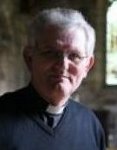 Phillip
Leslie Bishop (1970-71)
[pictured] came here briefly
after a curacy near Wolverhapton, then to
Middlesborough, then nine years with Ted Wickham's pioneering Sheffield Industrial Mission,
and then to parishes in Great Ayton and Guisborough. To raise funds, he
rode a horse up Roseberry Topping; he retired to Stockton in
2008.
Phillip
Leslie Bishop (1970-71)
[pictured] came here briefly
after a curacy near Wolverhapton, then to
Middlesborough, then nine years with Ted Wickham's pioneering Sheffield Industrial Mission,
and then to parishes in Great Ayton and Guisborough. To raise funds, he
rode a horse up Roseberry Topping; he retired to Stockton in
2008.<< Clergy 1729-1860 | << Clergy 1860-1900 | >> Licensed Workers